|
Sembach Air Base
Hahn Air Base
Bitburg Air Base
Kadena Air Base
Lowry Air Force Base
Orlando Air Force Base
Missile History I
Missile History II
Missile History III
The MM-1
Collectibles
Home Page
|
Site VIII - Idenheim
71st Tactical Missile Squadron

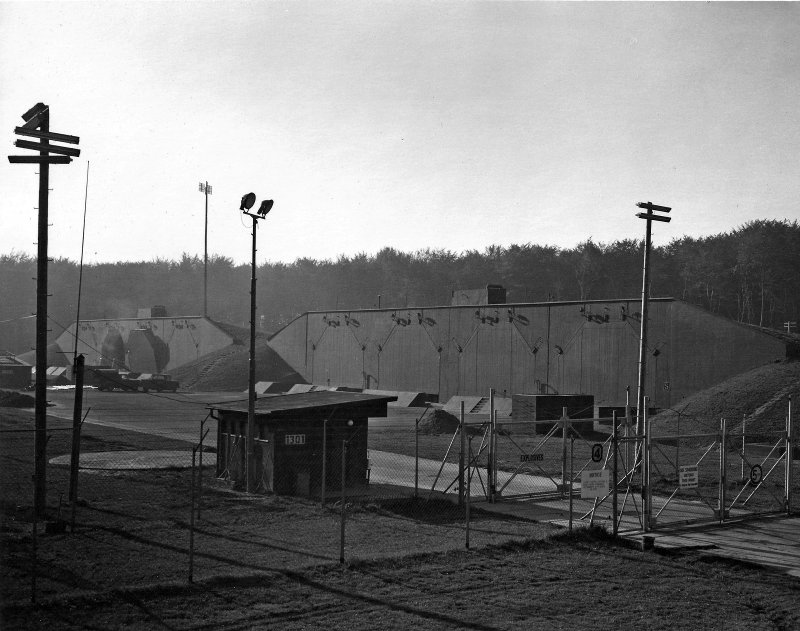
Site 8, Idenheim, with eight, launch-ready CGM-13B Mace missiles in 1966.
36th TFW photo courtesy of Wayne Douglas, 71st TMS, (lwd2856@aol.com)
[Editor's note: Guard shack ay Idenheim was on the left side of the entrance, at Rittersdorf it was on the right.]
|
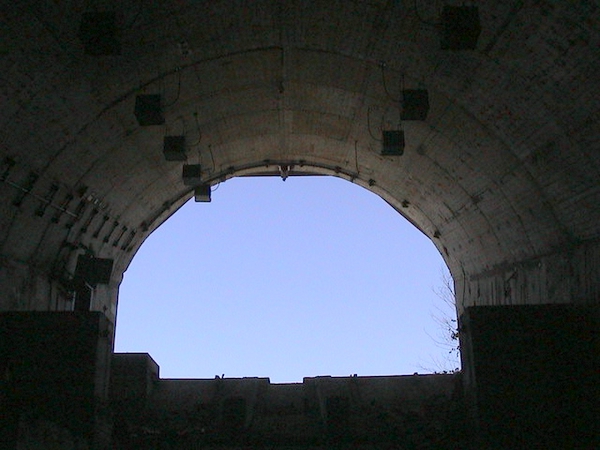
Photo from inside an abandoned launch bay at Idenheim, Germany, courtesy of Eric Zeppenfeld (info@bfw-vanhoffs.de)
|

U.S. Air Force Tactical Missiles
By the Editors of this Website!
|
Beyond the Web Page... The only book devoted exclusively to the Matador and Mace Tactical Missiles. The book reveals the story from the initial idea that became the first U.S. pilotless bomber, through the politically troubled development of the ever evolving deployment methods of the Matador and Mace Tactical Missiles. It covers the Units, Groups, Squadrons and Wing that fielded the missiles. From the United States test sites, Europe, Asia and North Africa nothing is omitted. All phases of the application of these two missiles by the U.S. Air Force (and West German Luftwaffe) are included, from the first tentative launches of the XSSM-A-1 Matador in January 1949, to the tense alert duty of the Cuban Missile Crisis, and the final launch of a MQM13A in May of 1977. The maintenance, logistics and launch, the men, equipment and tactics are all there.
|

|
"Bob, George, I finished your book 2 days after I received it. Couldn't put it down. It was incredible reading and incredibly detailed information."
Kent Washburn (KWASH55@aol.com) Mace B, Kadena, Okinawa
"George and Bob. I want you both to know how much I enjoyed reading and how much I admire and appreciate what you have accomplished in developing and publishing "The Pioneers". It is truly an outstanding piece of work, reflecting the time and effort required to produce it, but is also a formidable contribution to our military history. I mentioned in some earlier correspondence that I was a little disappointed in the relatively small amount of information regarding the Operating Location/Guidance Sites but you largely made up for it with this magnificent book."
Dale Lake (daleflake@yahoo.com) 601st Tactical Control Squadron, 38th TMW, Hamm, Germany
"I just finished your book, The Pioneers, et al. Please accept my "job well done!" Not only is it informative, but it's very readable. I'd also like to complement you on how well you footnoted it. You have shown that a scholarly work can be both instructive and enjoyable."
Michael Roof (lavinaschnur@hotmail.com) SGM USA (Ret.)
|

ISBN 978-0-557-00029-6
"Very good work with great detail."
Col. Charlie Simpson, USAF, Retired
Executive Director
Association of Air Force Missileers
"George, the book arrived on Tuesday while I was off to France. Of course, I quickly read the chapter about Germany's quiet step into the realm of nuclear armament. You know, this is still a widely ignored fact over here...
...For me it is fascinating to see what the picture really was in the 1950s and 1960s as opposed to what the official communication of the time wanted people to believe. A fascinating book shedding some light on the early days of tactical nuclear missiles as well as the political background that even today is still largely hidden behind the propaganda of the time. Can't wait to read the rest of it."
Burkhard Domke
Harsefeld, Germany
|
"I have your excellent book on USAF tactical missiles. I actually witnessed the decommissioning of the Maces at W�scheim back in 1966."
Paul Offen
Talitha, Tye Common Road
Billericay
Essex CM12 9PX
UK
"I just wanted to drop you a line and tell you how much I enjoyed the book that you and Bob wrote. The history was of particluar interest to me and my brother who was a history Professor at the University of Wisconsin. He also thought the book was well written, and he now knows what his little brother, (me), did while in Germany for three years."
George Joseph Snyder (gjsnyder@lanset.com)
71st TMS, Steinborn, Germany
"...by the way, I read your book, it was great, thanks for writing it."
Hack Hunton (hack@sstelco.com) Mace B, Kadena, Okinawa
|
|
US Air Force Tactical Missiles
© 2008 - George Mindling and Robert Bolton |
|
Inspired by the 38th TMW Website, George Mindling and Robert Bolton co-authored US Air Force Tactical Missiles 1949 - 1969: The Pioneers © 2008, the story of America's first operational missiles, from the Matador to the Mace, from Taiwan, Korea, and Okinawa to Germany, including Lowry, Orlando, Holloman, Santa Rosa Island at Eglin, and even Camp Happiness!
|
|
Dieses Buch ist ein Muss für alle, die im Rahmen ihres Dienstes bei der U.S. Air Force mit den frühen Marschflugkörpern
zu tun hatten, aber auch für deutsche Militärarchäologen, die in der Eifel, im Hunsrück oder im Pfälzer Wald schon
über rätselhafte Hinterlassenschaften gestolpert sind. Nach mehr als 40 Jahren wird endlich eine Fälle von Fakten,
Informationen und Geschichten zu den zwischen 1954 und 1969 in Deutschland stationierten, mit Automwaffen ausgerüsteten
amerikanischen Matador und Mace auf den Tisch gelegt.
Ausfährlich und lebendig erzählen George Mindling und Bob Bolton von den jungen Missilemen, die im März 1954 erstmals in Bitburg ankamen -
noch ganz grün im Gesicht, weil auf dem Atlantik schwerer Sturm geherrscht hatte. Von den T-33-Flugzeugen, die aus übungsgründen so taten, als
wären sie Matador-Flugkörper, äber die Startstellungen hinweg in Richtung deutsch-deutsche Grenze donnerten und sich von der Gegenseite
nur nicht erwischen lassen durften. Oder von der Kuba-Krise, als die US Air Force Europe auf DEFCON 3 ging und an die Mechaniker in
Bitburg Munition für ihre Karabiner ausgegeben wurde.
Augenzeugen sagen dazu: "Wir hätten die Vögel auf jeden Fall innerhalb von 15 Minuten in der Luft
haben müssen!" Es ist lebendige Militärgeschichte, die nun nicht der Vergessenheit anheimfällt, sondern
jedermann zugänglich wird - auch für die ortsansässige Bevökerung, die heute endlich erführt, was sich damals
in ihrer Nachbarschaft zugetragen hat. Den beiden Autoren gebührt der Dank.
Klaus Stark (klaus_stark@t-online.de)
Berlin, Germany
This book is not only a must for all those who served in the U.S. Air Force with the early cruise missiles, but also for German military archeologists who have been puzzling over relics stumbled across in the Eifel, the Hunsrück and the Palatinate Forests. After more than 40 years, we finally have a wealth of facts, information and stories, from 1954 to 1969, of the nuclear equipped American Matador and Mace missiles stationed in Germany placed on the table.
With detailed and vivid descriptions, George Mindling and Bob Bolton talk about the young Missilemen who arrived for the first time in March, 1954, in Bitburg - still green in the face, having prevailed the Atlantic crossing in major storm. Of the T-33 aircraft which practiced as if they Matador missiles launched in the direction of German-German border, or from the Cuban missile crisis, when the U.S. Air Force Europe went on DEFCON 3 and was issued ammunition to the mechanics in Bitburg for their rifles. Eyewitnesses say: "We would have to have the birds in the air in any event within 15 minutes!"
It is vital military history that is prey to oblivion, but is now accessible to everyone - even for the local population, which today finally learns what happened at that time in their neighborhood.
The two authors deserve thanks for saving the history.
Klaus Stark,
klaus_stark@t-online.de
Berlin, Germany
|
|

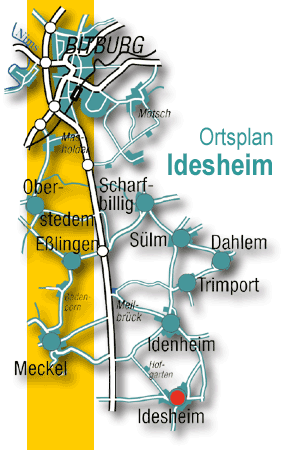 |
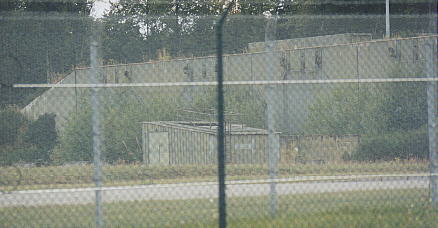
The abandoned Idenheim site, Summer 1993, after the US Army removed the Patriot missiles
that eventually followed the Mace "B"
The hardened launch bays, with their 100 ton doors,
were not used by the US Army. The Patriot missile launchers were positioned on the hard
pads in front of the launch doors.
The small metal structure in front of the launch
doors is the weather cover over the personnel stairwell. It also housed the winch used to
raise and lower heavy equipment from the 2 LCSC's 60 feet below. The roof also had a cutout
to allow the MC-1 cranes to be used for the really heavy lifts |

Metal indicator sign from Idenheim courtesy of Bernhard Gross (bernhardgross@t-online.de)
Bernhard Gross has compiled an impressive amount of data and information about the Mace-B hard sites that will be incorporated into this web site in the near future. |

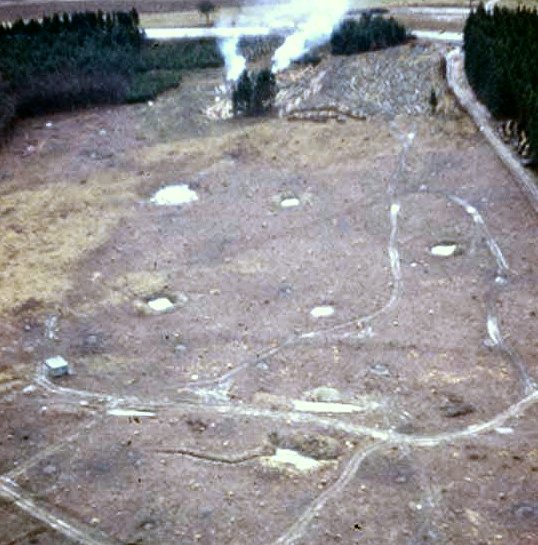 Clearing the land at Newel adjacent to the active TM-61C Matador "C" Pad for Idenheim Site VIII, January 1961. Clearing the land at Newel adjacent to the active TM-61C Matador "C" Pad for Idenheim Site VIII, January 1961.
|
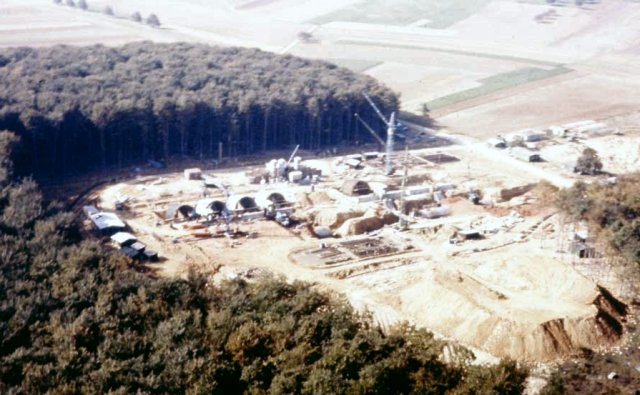 Construction underway at Site VIII, October 1961.
Construction underway at Site VIII, October 1961.
|
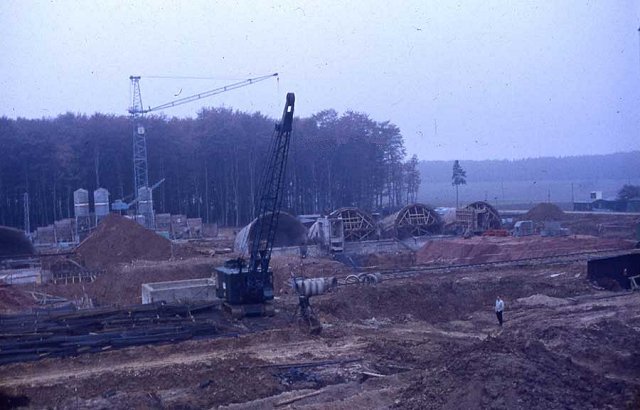
Construction underway at Idenheim Site VIII, November 1961
The first US Air Force launch and maintenance crews arrived less than three months later.
|
| The Photos above were contributed by Garld and Janice Edwards (geje@comcast.net), used with permission
|

The European Stars and Stripes article,
showing the launch door in the down position. July 12, 1964
The launch sites went operational June 27, 1964
The old Matador site at Idenheim was directly behind the
Mace hard site, shielded by the clump of trees. Just several hundred yards
beyond the trees is B-51, the heavily travelled Trier-Bitburg highway.
Photo: Stars and Stripes European Edition
|
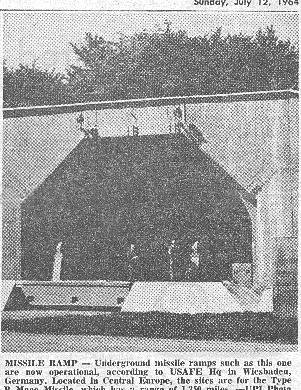
|

"I don't know what year it was, but we had
just gotten a new commander, don't remember names, so a simulated alert and launch was to be
done for him.
Well, you remember we had the code of the day to enter site??? The new commander was lead
down by the first Sgt and after the outer doors were closed behind them, he called to be let
in, without the code!
No code! We had a dilemma... We were pretty sure who was in the security chamber, but
we all voted and said either way we were in trouble, so we decided to call gate security and told
them we were going to break out the weapons. Well the alert call came, and for 1 1/2hrs we went
through the drills while the commander was locked in the security hold with 1st Sgt. When all
was clear we called gate and we got weapons. We sure had one embarrassed 1st Sgt. After we
verified all the I.D.s we let them all into the sites. The commander was impressed with what
we did, so in the long run all turned out well. The commander did not come down with-out
security calling down for an escort after that time."
Robert Bimbi, Launch, 71st TMS (rbim@peoplepc.com) |

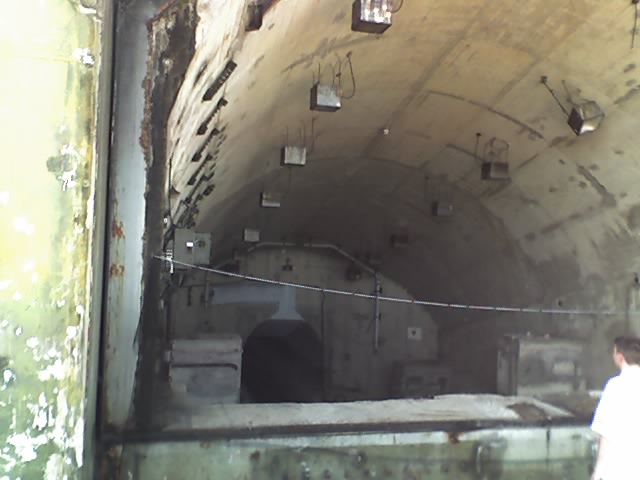
"I recently visited the Idenheim site and it has been turned into a paintball field. The place is trashed pretty badly but the bunkers are staying. The doors are not there anymore and it is harder to see them from the road due to the paintball setup. The owner was very nice and let me in to see the bunkers but he would not let me into the bunkers themselves. He has put up nets to keep people out. He says that German insurance laws require this. Sorry the quality isn't better. I was dodging paintballs.
Dave Bass Aug 2007 (tncbass@yahoo.com)
|

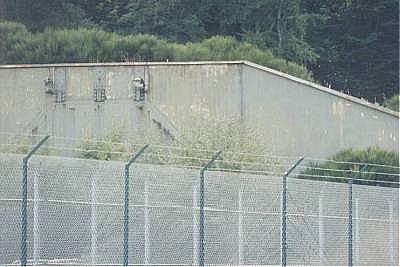 |
Close up of the Hardened launch site door,
Idenheim, August 1993. Guard dogs patrolled between the fences at night.
| 
A Different World - 1969
Two Mark 28's are moved back to MSA and the weapons area for deactivation at CGM-13B shutdown at Bitburg, April 30th 1969. The shape and size of the warheads can be seen as bulges against the transportation canvas
|
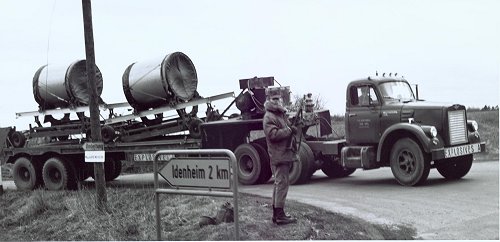
Warhead convoy back to MSA. Armed guards were posted in
visual site of each other the entire distance of the trip for every warhead convoy.
Martin/Marietta Photo courtesy of Kathy Geary (k.geary@worldnet.att.net) |

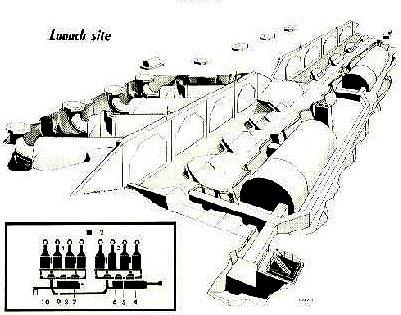
The planned layout for a hardened Mace B site.
Each of the two Launch Command Centers, buried 60 feet under the paved
loading and transport ramp, controls four launch bays.
The Mace site was called a "semi-hardened" launch site, even though the facility
was designed to withstand a nuclear attack.
Photo courtesy
of George F. Kovach
(GFKGDK@aol.com) |

|
Idenheim - Site VIII - 2007
"The area today is private property of a car dealer. I do not know his name but at the main gate you will find a plate with a telephone number. The area is completely fenced in (but I found a small hole in the fence at the backside near the forest and I visited the area on a quiet Sunday): The opened missile cells are gutted (cannibalized) and empty. Only the jet nozzles of the carbon dioxide fire extinguisher pipes at the exhaust channel entry and some lamps you can see. All outer and inner doors are dismantled and scrapped.
In the stairways down to the underground rooms all lamps, conductions and wires are dismantled.
Downstairs I could see that the underground corridor (and accordingly all the rooms) are under water for more than one meter of water depth.
Because of that ground water situation I do not know anything about the technical installations and the underground interior of the Idenheim underground rooms, may be it is still there or may be it became scraped. I do not know.
I visited the Idenheim station last time in March 2007, some weeks ago."
Bernhard Gross (bernhardgross@t-online.de)
|
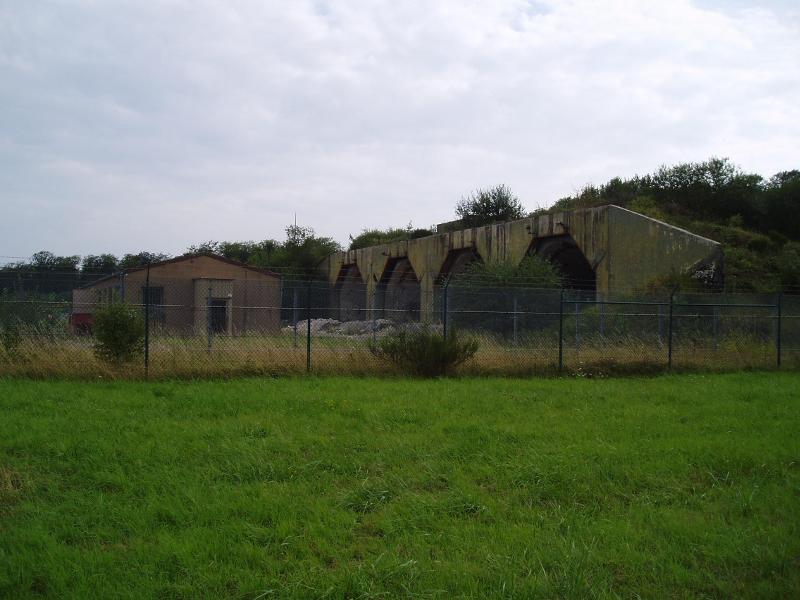
Site VIII, Idenheim, March 2007
|

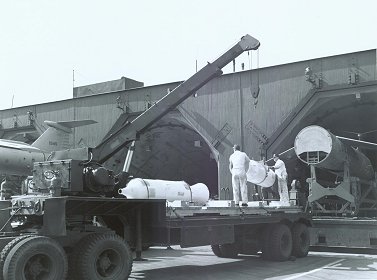
S/Sgt Roberson and S/Sgt
Alexander unload and prepare Thiokol RATO bottles for installation on the TM-76B (CGM-13B)
Mace
Photo courtesy of Kathy Geary
(k.geary@worldnet.att.net)
|
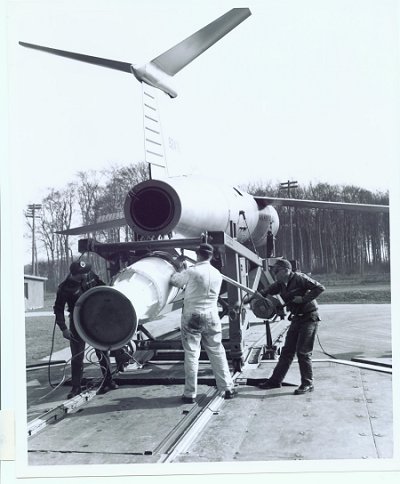
Hooking up the bomb hoists to lower
the RATO bottle on a CGM-13B Mace.
Crew members are Sgt Murray, S/Sgt Alexander, and S/Sgt Smith.
Photo taken on the door at Bay 80 at Idenheim.
|
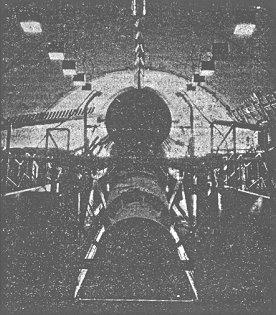
TM-76B (CGM-13B) Mace in launch position.
The hydraulic system is powered up for acceptance test, (1500 PSI supplied by an
external Hydraulic Power Supply, HPS) but the Flight Controls System has not yet gone active
(left spoilers full up.)
The two nozzles aimed at the tailpipe are water nozzles
used during firing of the RATO bottle.
Photo: Stars and Stripes European Edition |

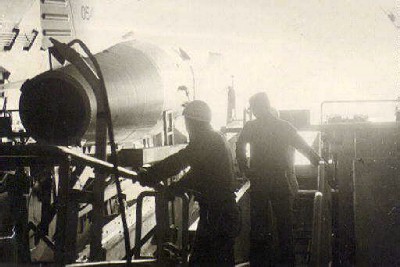
Above: A&E (E&A) troops load a missile for transport
back to the MSA |

Idenheim, Kreis Bitburg, Germany - "C" Pad - Site VIII - 2005
( 49 ° 53' 22.17" N, 6 ° 33' 27.21" E. ) |
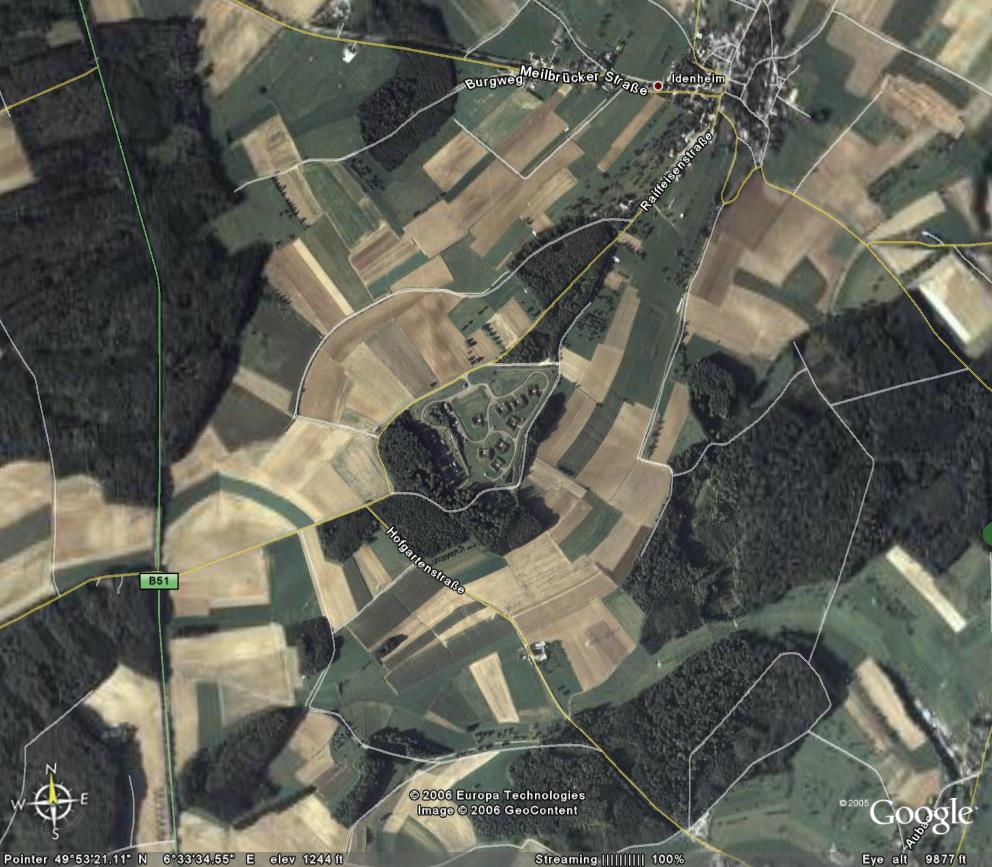 |
Photo Courtesy of Google Earth
|

This page is in no way sponsored or endorsed by the United States Air Force.
Opinions and views expressed are those of the author and not necessarily those of the
Department of the Air Force.
|
All Contributions remain the property of the original owners
All Contributions used with Permission
Web Page Design and Development by
George Mindling - Port Charlotte, Florida
|
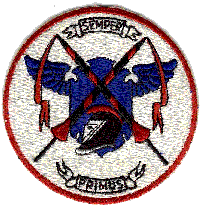



















 Clearing the land at Newel adjacent to the active TM-61C Matador "C" Pad for Idenheim Site VIII, January 1961.
Clearing the land at Newel adjacent to the active TM-61C Matador "C" Pad for Idenheim Site VIII, January 1961.
 Construction underway at Site VIII, October 1961.
Construction underway at Site VIII, October 1961.
